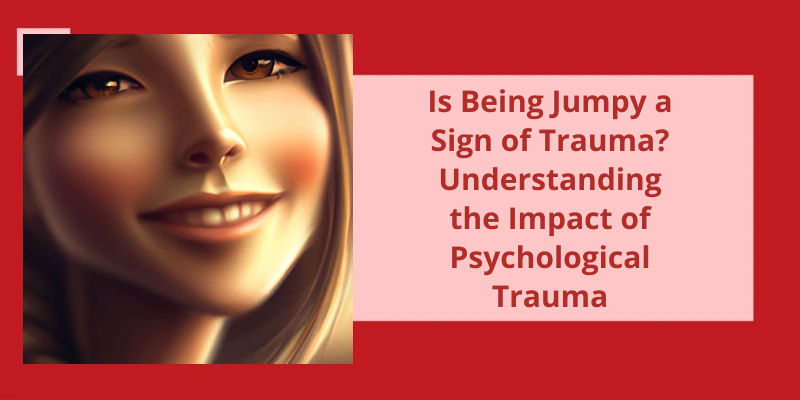Trauma is a complex and often misunderstood phenomenon that affects individuals in a variety of ways. One common symptom of trauma is hyperarousal, a state in which the body is constantly in a state of alertness. This can manifest in a number of ways, including heightened startle responses, feelings of being constantly on edge, and an increased sensitivity to sounds and sights. While many people experience some degree of hyperarousal following a traumatic event, for some individuals these symptoms can persist for months or even years, interfering with their daily lives and relationships. For those with post-traumatic stress disorder (PTSD), in particular, being jumpy or easily startled is often a hallmark symptom. Despite it’s prevalence, however, the link between being jumpy and trauma isn’t always clear-cut, and further research is needed to better understand the complex relationship between these two phenomena.
Is Being Jumpy a Sign of PTSD?
Post-traumatic stress disorder (PTSD) is a mental health condition that can develop after experiencing or witnessing a traumatic event. Common symptoms of PTSD include vivid flashbacks, avoidance of triggering situations, and intense anxiety or panic attacks. However, being jumpy or hyper-vigilant is also a physical symptom that many people with PTSD experience. This heightened state of anxiety and awareness is often a reaction to the bodys fight-or-flight response, which can become activated by even minor triggers following a traumatic event.
It can make it hard to relax, sleep, or feel comfortable in social situations. Often, PTSD sufferers will have a persistent feeling of being unsafe, even in situations that are otherwise normal or non-threatening. This can lead to feelings of isolation and mistrust, as well as difficulty forming close relationships with others.
Most experts believe that being jumpy is a normal response to a traumatic event, and isn’t a sign of weakness or mental illness. However, when these symptoms persist for more than a few weeks, it may be time to seek help from a mental health professional. Treatment options for PTSD may include medications, therapy, and lifestyle changes designed to reduce stress and promote relaxation.
These can include anxiety, depression, anger, irritability, and a loss of interest in activities that were once enjoyable. It’s important to be aware of these symptoms and seek help if they persist or interfere with daily life.
While it’s a normal response to trauma, it’s important to seek help if these symptoms persist or interfere with daily life.
How to Recognize PTSD in Yourself or a Loved One
PTSD, or Post-Traumatic Stress Disorder, is a mental health condition that can develop after experiencing or witnessing a traumatic event. Symptoms may include flashbacks, avoidance of triggers, anxiety, and irritability. If you or a loved one are experiencing these symptoms, it’s important to seek professional help.
However, prolonged or intense reactions may indicate the presence of trauma-related disorders such as Acute Stress Disorder, Post-Traumatic Stress Disorder (PTSD), or Complex PTSD. These disorders can have a significant impact on a person’s daily life, relationships, and overall well-being. In this article, we’ll dive deeper into the signs of a traumatized person and how to offer support.
What Are Signs of a Traumatized Person?
However, when these reactions persist or intensify, they may signal the development of post-traumatic stress disorder (PTSD) or another trauma-related disorder. PTSD is characterized by four clusters of symptoms: re-experiencing, avoidance, negative alterations in cognition and mood, and hyperarousal. Re-experiencing symptoms may include flashbacks, nightmares, and intrusive thoughts that cause distress and physical reactions such as sweating, trembling, and racing heartbeats. Avoidance symptoms may involve efforts to avoid trauma-related stimuli, numbing, detachment, and avoidance of feelings and activities that used to give pleasure. Negative alterations in cognition and mood may manifest as self-blame, guilt, shame, diminished interest, detachment, and distorted beliefs about oneself, others and the world. Hyperarousal symptoms may include irritability, anger, hypervigilance, difficulty concentrating, exaggerated startle response, and sleep disturbances.
In addition to PTSD, victims of trauma may experience other emotional and behavioral problems such as depression, substance abuse, eating disorders, self-injury, dissociative disorders, and somatic complaints. Trauma may also affect interpersonal relationships, work and academic performance, and lead to legal and financial difficulties. Common challenges faced by individuals with trauma include difficulties trusting others, feeling safe, and establishing intimacy. Many traumatized people may feel ashamed, guilty, or stigmatized, and may avoid seeking help due to fear of judgment or re-experiencing.
It’s important to recognize that there’s no one-size-fits-all approach to healing from trauma. Trauma survivors may benefit from different types of treatments, including psychotherapy, medication, supportive services, and alternative interventions. Trauma-focused psychotherapies such as cognitive-behavioral therapy (CBT), exposure therapy, and eye movement desensitization and reprocessing (EMDR) have been found to be effective for reducing PTSD symptoms. Medications such as antidepressants and antipsychotics may also be prescribed to manage certain symptoms. Supportive services such as peer support, self-help groups, and advocacy may provide emotional validation, validation, and other forms of support. Alternative interventions such as yoga, mindfulness, art therapy, and equine-assisted therapy may help trauma survivors cope with stress and regulation.
Recognizing the signs of trauma and seeking help can make a world of difference for those affected by it. It’s important to understand that trauma affects people differently and that each persons healing process is unique. Trauma survivors aren’t alone and there are many resources available to help them on their journey to recovery. If you or someone you know is experiencing trauma-related symptoms, it’s important to seek professional help and know that there’s hope for healing and resilience.
Experiencing trauma can have a significant impact on an individual’s emotional and cognitive responses. In some cases, trauma can lead to memory lapses or instances of “lost time.” According to Schauer & Elbert (2010), there are six main reactions to trauma: Freeze, Flight, Fight, Fright, Flag, and Faint. Understanding these stages can help individuals better recognize and manage their own trauma responses.
What Are the 6 Reactions to Trauma?
Trauma is defined as an experience, or threat of an experience, that’s potentially damaging or harmful to an individuals physical, emotional, or psychological well-being. The impact of trauma can cause a variety of reactions that are unique to each individual and can be varied in intensity. Research suggests that there are six primary trauma reactions: Freeze, Flight, Fight, Fright, Flag, and Faint.
The freeze response, also known as immobilization, is a natural physiological response that occurs when an individual perceives a situation as potentially life-threatening and skills such as fighting or running away may not be suitable. The freeze response causes the body to temporarily shut down, leading to a sense of numbness, disorientation, or confusion. Sometimes people may also feel derealized, meaning they don’t feel present in reality. The freeze response is often seen in individuals who’ve experienced high levels of ongoing trauma.
The flight response is a reaction that occurs when individuals feel like they need to get away from a potentially harmful situation as quickly as possible. It’s often described as a sense of panic or urgency and is characterized by feelings of anxiety, fear, or an overwhelming sense of danger. This reaction is highly adaptive in cases where individuals are faced with immediate danger.
The fight response occurs when people react to a traumatic situation with aggression and physical force in an attempt to defend themselves or those around them. Although this is a natural response, it can be problematic and potentially dangerous if someone is fighting against an unstoppable opponent. The use of aggression can cause collateral damage and increase the risk of further physical or emotional harm.
The fright reaction is characterized by a sense of overwhelming terror or helplessness. This reaction is often seen in people who experience intense trauma, such as natural disasters, war, or violent crime. It can also lead to symptoms such as flashbacks, severe anxiety, difficulty sleeping, or depression.
The flag response, also known as submission or compliance, is a reaction where individuals respond to trauma by “giving in” to the demands or actions of another person or situation. This response may occur in situations where escape or attack isn’t possible, leading to a sense of helplessness. The flag response is often seen in survivors of physical, emotional, sexual, or financial abuse.
The faint response, also known as collapse, is experienced by individuals who feel overwhelmed by a situation that they feel is potentially life-threatening. This reaction can also occur when individuals feel helpless or out of control. The faint response can lead to a decrease in blood pressure and a slowing of heart rate, which can result in a person fainting or losing consciousness.
While these reactions may be adaptive in some situations, they can also be problematic or potentially harmful if they occur in response to non-threatening situations. Evaluation and appropriate treatment by a licensed mental health professional are often necessary to manage and cope with the effects of trauma and it’s accompanying symptoms.
The way our bodies react to certain stimuli can reveal much about our mental state. For those who suffer from trauma, a heightened startle response may manifest in various ways, from overreacting to minor disturbances to flinching at familiar sounds. In this article, we delve deeper into the role that flinching plays in trauma and explore it’s impact on those who experience it.
Is Flinching a Sign of Trauma?
Flinching is often considered an involuntary physical reaction that occurs in response to an unexpected stimulus. It’s not always a sign of trauma, but it can be an indicator of underlying issues related to anxiety, stress, or PTSD. One of the most common triggers for flinching is a heightened startle response. This can be anything from reacting excessively to a tap on the shoulder, to flinching when being called by name.
Trauma is unique to each individual, and the way people react to it can vary widely. However, flinching can be a common symptom of PTSD. Beyond just physical reactions, PTSD can also cause emotional and cognitive symptoms that lead to challenges in everyday life. These symptoms often make it difficult for those suffering from PTSD to engage with others and cope with the world around them.
When someone experiences a traumatic event, the brain can start to associate certain stimuli with danger, leading to exaggerated reactions. The body then enters a state of heightened alertness, with the fight or flight response kicking in at even the slightest hint of danger. This can cause people to feel anxious and on edge, leading to a range of physical and emotional symptoms.
There are many different reactions someone may experience in response to a traumatic event, and these can vary significantly depending on individual experiences.
Rather than relying solely on physical symptoms, it’s important to take a holistic approach to understanding and addressing trauma, including support from mental health professionals and loved ones.
The Long-Term Effects of Experiencing Trauma and How Flinching Fits Into This Picture
Trauma can have lasting effects on a person’s mental and emotional well-being. Flinching, a physical reaction to perceived danger or threat, is often a symptom of trauma and can be a reminder of past traumatic experiences. The significance of flinching within the context of trauma lies in understanding the complex ways that traumatic experiences can shape a person’s long-term emotional responses.
It’s important to note that not everyone who experiences trauma will exhibit these specific symptoms or react in the same way. Additionally, some individuals may not develop symptoms until weeks or months after the traumatic event. Seeking professional help from a therapist or mental health provider can greatly benefit those experiencing psychological trauma. In the next section, we will explore some possible treatments for those struggling with trauma.
What Are 3 Symptoms of Psychological Trauma?
However, for some individuals, the effects of trauma can linger on for months or even years, causing significant impairment in their daily lives. These individuals may experience a wide range of symptoms, including emotional numbness, dissociation, depression, and hypervigilance. Of all these symptoms, three stand out as the most common indicators of psychological trauma.
Flashbacks are vivid, intrusive memories of the traumatic event that can be triggered by sights, sounds, smells, or other sensory stimuli associated with the experience. They may feel as though they’re reliving the event, which can cause intense emotional distress.
Nightmares are another symptom of psychological trauma that can be quite distressing. These are vivid and disturbing dreams that are often related to the traumatic event. Nightmares can cause intense fear and anxiety, and individuals may avoid going to sleep altogether out of fear of experiencing them.
Severe anxiety is also a common symptom of psychological trauma. This can manifest in many ways, including difficulty concentrating, agitation, irritability, and constant worry. Individuals may feel on edge all the time, as though they’re waiting for something terrible to happen. They may also experience panic attacks, which are sudden and intense bursts of fear and anxiety that can be very disruptive to their lives.
With the right support and treatment, it’s possible to recover from trauma and lead a happy, healthy life. It’s important to remember that healing from psychological trauma is a journey, and that it may take time and effort to find the help and support you need.
Explore the Long-Term Effects of Unaddressed Trauma on a Person’s Mental Health and Overall Well-Being.
This topic delves into the negative impacts that unaddressed trauma can have on an individual’s mental health and overall well-being over a prolonged period of time.
Conclusion
In conclusion, while being jumpy alone isn’t necessarily a definitive sign of trauma, it’s a common symptom experienced by individuals with PTSD. By understanding the symptoms and seeking proper treatment, those suffering from PTSD can begin to find relief from the hypervigilance and heightened startle response that come with the condition. It’s important to acknowledge and address the complex nature of trauma and it’s effects, in order to move towards healing and recovery.






